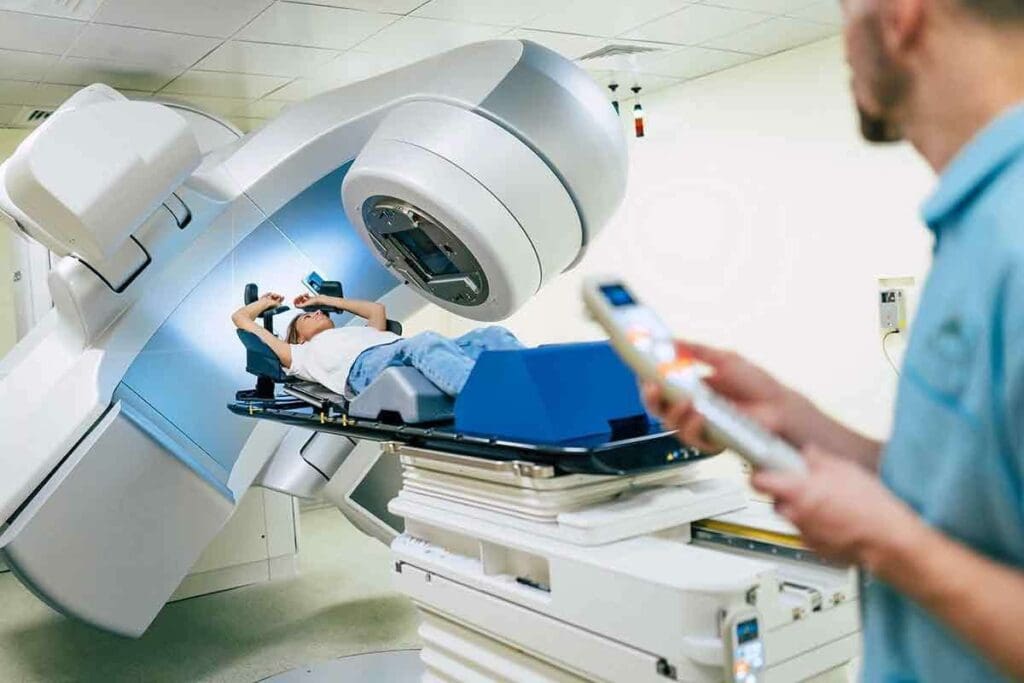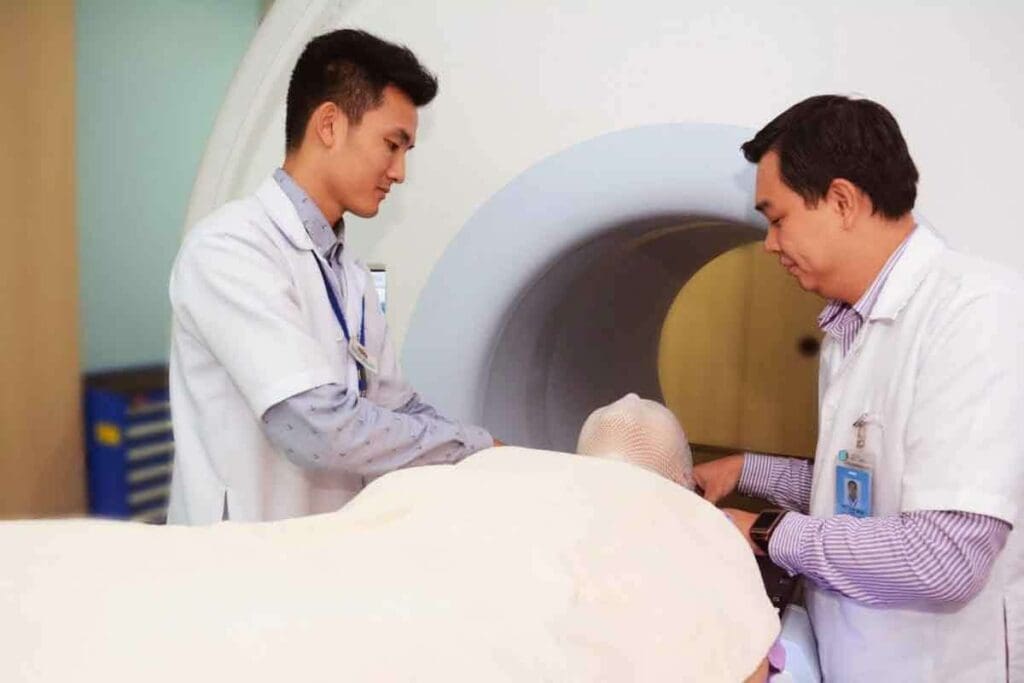Last Updated on November 27, 2025 by Bilal Hasdemir
At Liv Hospital, we use radiation therapy as a key part of cancer treatment. We use different kinds of radiation to kill cancer cells. Almost half of all cancer patients get radiation therapy as part of their treatment.

Radiation therapy sends high-energy beams to treat cancer. It targets the DNA in cancer cells. This treatment helps us precisely hit tumors, giving hope to those seeking advanced care.
Key Takeaways
- Radiation therapy is a key part of cancer treatment.
- We use different kinds of radiation to target cancer cells.
- Nearly half of all cancer patients get radiation therapy.
- Liv Hospital is a leader in safety and patient-centered care.
- Radiation therapy targets the DNA inside cancer cells.
Understanding Radiation Therapy in Cancer Treatment
Radiation therapy is a key part of cancer treatment, giving hope to people all over the world. It works by aiming at the DNA of cancer cells to stop them from growing. Modern technology helps target tumors accurately, protecting healthy tissue.
How Radiation Therapy Works to Destroy Cancer Cells
Radiation therapy damages the DNA of cancer cells, causing them to die. It uses high-energy particles or waves to stop cells from dividing. This way, it stops cancer from growing, helping treat different types of cancer.
The success of radiation therapy comes from its ability to focus on cancer cells. New technologies have made it even more precise. This means more radiation can go to tumors, while healthy tissue is protected.
The Evolution of Radiation Therapy Technologies
The field of radiation therapy technologies has grown a lot, thanks to new ideas in medical physics and engineering. Today, we have many methods like external beam radiation therapy (EBRT), brachytherapy, and stereotactic body radiation therapy (SBRT). These new ways have made treatments better, more comfortable for patients, and with fewer side effects.
As we keep improving radiation therapy technologies, we’re moving towards more tailored treatments. We’re using imaging and real-time monitoring to make radiation doses more accurate. This helps protect healthy tissues even more.
The Science Behind Different Types of Radiation Therapy
It’s important to know how radiation therapy works to understand its role in fighting cancer. This treatment uses different kinds of radiation to kill cancer cells. The type of radiation used can greatly affect how well the treatment works.
Types of Radiation Used: X-rays, Gamma Rays, Electrons, Protons, and Neutrons
There are many types of radiation used in radiation therapy, each with its own special features and uses. These include:
- X-rays: High-energy X-rays are often used to treat many types of cancer. They can go deep into the body, making them good for tumors inside the body.
- Gamma Rays: Gamma radiation is used in some treatments, like Gamma Knife radiosurgery. It’s mainly used for brain tumors.
- Electrons: Electron beams are used for tumors close to the surface. They don’t go as deep as X-rays.
- Protons: Proton therapy uses protons instead of X-rays. It’s great for tumors near important areas because it’s more precise.
- Neutrons: Neutron therapy is less common but treats some tumors that other radiation can’t.
How Radiation Affects Cancer Cells vs. Healthy Cells
Radiation therapy damages the DNA of cancer cells, stopping them from growing. It can also harm healthy cells, but modern methods try to reduce this. They do this by:
- Targeting the tumor precisely
- Choosing the right type and amount of radiation
- Splitting the radiation into smaller doses to help healthy cells recover
By knowing how radiation affects both cancer and healthy cells, doctors can make better treatment plans. These plans aim to get the most benefit while causing fewer side effects.
External Beam Radiation Therapy (EBRT)
External Beam Radiation Therapy (EBRT) is a key part of cancer treatment. It’s a non-surgical method that uses high-energy beams to kill cancer cells.
How EBRT Works and Treatment Process
EBRT sends radiation beams from outside the body to the tumor. The first step is simulation, where CT scans help find the tumor and plan the best angle for the beams.
Next, we make a treatment plan. We figure out the right dose of radiation to kill the tumor without harming healthy tissues.
Linear Accelerators and Delivery Methods
Linear accelerators are the main machines for EBRT. They speed up electrons to make X-rays that target the tumor.
Types of EBRT Delivery Methods:
- 3D Conformal Radiation Therapy (3D-CRT)
- Intensity-Modulated Radiation Therapy (IMRT)
- Image-Guided Radiation Therapy (IGRT)
- Volumetric Modulated Arc Therapy (VMAT)
Common Cancer Types Treated with EBRT
EBRT can treat many cancers. Some examples include:
| Cancer Type | Description |
| Breast Cancer | EBRT is often used after surgery to eliminate any remaining cancer cells. |
| Prostate Cancer | EBRT can be used as a primary treatment, delivering precise doses of radiation to the prostate gland. |
| Lung Cancer | EBRT is used to treat both early-stage and advanced lung cancer, sometimes in conjunction with other treatments. |
Brachytherapy: Internal Radiation Therapy
Brachytherapy places radioactive sources inside or near tumors to kill cancer cells. It’s used for many cancers, like cervical, prostate, and breast cancer.
Permanent vs. Temporary Implants
Brachytherapy uses either permanent or temporary implants. Permanent implants are small radioactive seeds left in the tumor. They keep emitting radiation until they lose their radioactivity. Temporary implants are removed after a set time, placing radioactive material near the tumor.
Choosing between permanent and temporary implants depends on the cancer type, stage, and the patient’s health. Our team helps decide the best brachytherapy for each patient.
High-Dose Rate vs. Low-Dose Rate Brachytherapy
Brachytherapy is also divided by dose rate. High-Dose Rate (HDR) brachytherapy gives a high dose in a few minutes. It’s often used with other treatments and may need many sessions. Low-Dose Rate (LDR) brachytherapy gives a lower dose over days.
Cancer Types Most Suitable for Brachytherapy
Brachytherapy works best for cancers that are localized or haven’t spread far. It’s great for:
| Cancer Type | Description |
| Prostate Cancer | Brachytherapy treats early-stage prostate cancer well, with few side effects. |
| Cervical Cancer | It’s used with external beam radiation for cervical cancer, targeting the tumor effectively. |
| Breast Cancer | Brachytherapy is used for breast cancer, often after lumpectomy, to kill remaining cells. |
Knowing about brachytherapy types helps patients choose their treatment. Our team offers full care and support during treatment.
Stereotactic Radiosurgery (SRS)
SRS is very precise, treating tumors in sensitive areas with care. It’s a key option for brain and spinal tumors. This method of radiation therapy is highly specialized.
Precision Treatment for Brain and Spinal Tumors
SRS uses advanced imaging and robotics for accurate radiation delivery. It’s vital for treating tumors in complex or sensitive areas. This includes the brain and spine.
It minimizes damage to healthy tissue around tumors. This reduces side effects and complications. It’s a good choice for patients not suited for traditional surgery.
Gamma Knife and CyberKnife Technologies
Gamma Knife and CyberKnife are advanced SRS technologies. The Gamma Knife uses cobalt to target brain tumors precisely.
CyberKnife is a robotic system that treats tumors in the body, including the spine. Both offer high precision and flexibility for complex tumors.
Single vs. Multiple Session Treatments
SRS can be a single session or multiple sessions. It depends on the patient’s needs and the tumor’s characteristics.
Single sessions are for smaller, well-defined tumors. Larger or more complex tumors might need multiple sessions.
Our team works with patients to find the best treatment plan. We consider the latest research and guidelines.
Stereotactic Body Radiation Therapy (SBRT)
SBRT is a key treatment for many cancers. It’s precise and has fewer side effects. This method is used for tumors outside the brain and spine.

Targeting Tumors Outside the Brain and Spine
SBRT is great for tumors in the lungs, liver, and pancreas. It delivers radiation right to the tumor. This way, it harms less of the healthy tissue around it.
Key benefits of SBRT include:
- High precision in targeting tumors
- Non-invasive treatment option
- Reduced risk of side effects
- Shorter treatment duration compared to traditional radiation therapy
Treatment Planning and Delivery Process
The SBRT process is detailed and precise. We use advanced imaging to find the tumor and plan the treatment. The actual treatment is given in a few sessions, each lasting just a few minutes.
The treatment planning process includes:
- Detailed imaging to identify the tumor’s location and size
- Creation of a customized treatment plan
- Precise delivery of radiation using advanced technology
Benefits for Early-Stage Cancers
SBRT is a top choice for early-stage cancers. It can cure or control the cancer, improving life quality.
It’s also good for those who can’t have surgery. SBRT is a non-invasive option that works well with fewer risks.
Proton Therapy: Advanced Precision Treatment
Proton therapy is changing cancer treatment by focusing radiation on tumors while protecting healthy tissue. It’s a precise way to treat tumors close to important areas. This makes it a valuable option for many patients.
How Proton Therapy Differs from Traditional Radiation
Proton therapy is different from traditional X-ray therapy. It uses protons to target tumors with great accuracy. This is because protons deposit most of their energy in the tumor.
Key differences between proton therapy and traditional radiation therapy include:
- Precision targeting of tumors
- Reduced damage to surrounding healthy tissues
- Ability to treat tumors near critical structures
The Bragg Peak Advantage
The Bragg peak is a big advantage of proton therapy. It’s when protons lose energy sharply as they pass through tissue. This means a high dose goes to the tumor, but not to nearby tissues. This makes proton therapy more effective than traditional radiation.
Ideal Candidates for Proton Therapy
Proton therapy is best for tumors near important areas like the brain or spine. It’s also good for large or complex tumors, or those who’ve had radiation before. The choice to use proton therapy depends on the patient’s specific situation.
| Cancer Type | Benefits of Proton Therapy | Clinical Considerations |
| Brain Tumors | Precision targeting reduces damage to surrounding brain tissue | Ideal for tumors near critical brain structures |
| Pediatric Cancers | Minimizes long-term side effects by sparing healthy tissues | Preferred for young patients to reduce developmental impacts |
| Prostate Cancer | High dose delivery to the tumor with minimal rectal toxicity | Considered for localized prostate cancer |
Understanding proton therapy’s benefits helps doctors give patients better treatment options. This is true for many types of cancer.
Different Types of Radiation Therapy for Specific Cancers
Using the right radiation therapy for each cancer is key. It helps treat the cancer well and keeps side effects low. We’ll look at how different cancers are treated with radiation, like as breast, prostate, and head and neck cancers.
Radiation Approaches for Breast Cancer
Breast cancer often gets treated with radiation. This can be from outside the body or inside. Radiation therapy can be used before or after surgery.
Brachytherapy is another method. It uses a small radioactive implant in the breast. This method gives a strong dose of radiation right to the tumor, protecting healthy tissue.
Radiation Strategies for Prostate Cancer
Prostate cancer treatment often includes radiation. Options are EBRT, brachytherapy, and proton therapy. EBRT targets the prostate from outside, while brachytherapy places radioactive seeds inside.
Proton therapy is also used. It delivers precise radiation, reducing damage to healthy tissue. The choice depends on the cancer’s stage and the patient’s health.
| Radiation Therapy Type | Description | Benefits |
| EBRT | External beam radiation therapy targeting the prostate gland | Non-invasive, effective for localized cancer |
| Brachytherapy | Radioactive seeds are implanted directly into the prostate | High dose delivery to the tumor, minimal side effects |
| Proton Therapy | Precise radiation delivery using proton beams | Reduced damage to surrounding healthy tissues |
Specialized Treatments for Head and Neck Cancers
Head and neck cancers need special radiation therapy. Intensity-Modulated Radiation Therapy (IMRT) is often used. It targets tumors precisely while protecting other tissues.
Proton therapy is also used, mainly for tumors near important areas like the brain. It aims to give a strong dose to the tumor while protecting healthy tissue.
Neutron Beam Therapy and Other Specialized Approaches
Neutron beam therapy is unique in treating certain tumors. We’ll look at this and other specialized radiation methods. We’ll talk about how they work, their uses, and the hurdles in getting them.
How Neutron Therapy Works
Neutron beam therapy sends a beam of neutrons to tumors. This therapy is great for tumors that don’t respond well to other treatments. Neutrons can damage these cells more than other types of radiation.

Treating Radioresistant Tumors
Radioresistant tumors are hard to treat. They don’t react well to usual radiation therapy. Neutron therapy is a hope for these cancers, like some salivary gland tumors and soft tissue sarcomas. It kills cancer cells by damaging their DNA.
Availability and Access Challenges
Neutron beam therapy is not easy to get. The special equipment needed is rare. Only a few places worldwide offer this therapy. This makes it hard for patients to get it.
In summary, neutron beam therapy is a key option for hard-to-treat tumors. Though there are big challenges, its benefits are worth exploring further in radiation oncology.
Image-Guided Radiation Therapy (IGRT)
IGRT has changed how we treat cancer. It uses images during treatment to make sure the radiation hits the right spot.
Real-Time Imaging During Treatment
IGRT uses X-rays, CT scans, or ultrasound for real-time images of tumors. This lets doctors adjust the radiation beam to hit the tumor exactly.
Real-time imaging is key in IGRT. It helps doctors deal with any tumor movement or changes in the patient’s body during treatment. This is very important for tumors near important structures or those that move with breathing.
Improving Precision and Reducing Side Effects
IGRT makes sure the radiation hits the tumor right on. This makes treatment more effective and reduces side effects by protecting healthy tissues.
Integration with Other Radiation Approaches
IGRT works well with other radiation methods like IMRT and SBRT. This makes these treatments even more precise and effective.
In summary, IGRT is a big step forward in radiation therapy. It makes treatments more precise and reduces side effects. Its use with other methods keeps improving cancer treatment results.
Managing Side Effects of Radiation Treatments
Radiation therapy fights cancer but can cause side effects. These can range from mild to severe, based on the area treated and dosage.
Common Side Effects and Mitigation Strategies
Radiation therapy can lead to fatigue, skin changes, and hair loss. Mitigation strategies are key to reducing these effects. Keeping the skin clean and using gentle products can help with skin reactions.
To fight fatigue, patients should save energy, take breaks, and do light exercises. Eating right and getting help with digestion can also help.
| Side Effect | Mitigation Strategy |
| Fatigue | Conserve energy, take regular breaks, gentle exercises |
| Skin Changes | Maintain good skin hygiene, and use gentle skin products |
| Hair Loss | Use gentle hair care products, consider scalp cooling |
Short-Term vs. Long-Term Effects
Side effects can be short-term or long-term. Short-term effects happen during or right after treatment. These include fatigue, skin reactions, and hair loss. Long-term effects can take months or years to show up. They might include fibrosis, secondary cancers, or organ problems.
Knowing about long-term effects is important for ongoing care. Regular check-ups with healthcare providers can help manage any new issues.
Supportive Care During Radiation Therapy
Supportive care is key in managing side effects and improving life quality for patients. It includes nutrition, psychological support, and physical therapy.
It’s important for patients to talk about their symptoms and worries with their healthcare team. This support can help patients handle treatment better and recover faster.
Understanding side effects and using supportive care can help patients get through radiation therapy. This way, they can reduce discomfort and get better results.
Conclusion: The Future of Radiation Therapy in Cancer Treatment
Radiation therapy is key in fighting cancer, with many techniques to choose from. Each method, like External Beam Radiation Therapy (EBRT) and Brachytherapy, has its own strengths. Stereotactic Radiosurgery (SRS) and Proton Therapy also play important roles.
The future of radiation therapy looks bright. New technologies are making treatments more precise and tailored to each patient. These advancements are making therapy more effective, reducing side effects, and improving life quality for patients.
Big changes are happening in the field, like the use of Image-Guided Radiation Therapy (IGRT) and the growth of proton therapy facilities. These changes are set to change cancer treatment for the better, giving hope to patients everywhere.
As research and technology keep improving, we’ll see even better treatments. Radiation therapy will continue to play a big part in fighting cancer. The future is full of promise, with new innovations leading to better care and outcomes for patients.
FAQ
What are the different types of radiation therapy used in cancer treatment?
There are many types of radiation therapy. These include External Beam Radiation Therapy (EBRT), Brachytherapy, and Stereotactic Radiosurgery (SRS). Also, Stereotactic Body Radiation Therapy (SBRT), Proton Therapy, and Neutron Beam Therapy are used.
How does radiation therapy work to destroy cancer cells?
Radiation therapy damages the DNA of cancer cells. This stops them from dividing and leads to cell death. It aims to give a precise dose of radiation to the tumor, while protecting healthy tissues.
What is the difference between External Beam Radiation Therapy (EBRT) and Brachytherapy?
EBRT sends radiation from outside the body to the tumor. Brachytherapy places a radioactive source inside or near the tumor. EBRT is more common and treats many cancers. Brachytherapy is used for tumors that are close to the surface.
What is Stereotactic Radiosurgery (SRS) and how is it used?
SRS is a precise radiation therapy for brain and spine tumors. It gives a high dose of radiation in one or a few sessions. Technologies like Gamma Knife and CyberKnife are used.
What is Proton Therapy, and how does it differ from traditional radiation therapy?
Proton Therapy uses protons to kill cancer cells. It delivers a precise dose of radiation to the tumor with less damage to surrounding tissues. This is thanks to the Bragg Peak effect.
What are the common side effects of radiation therapy, and how can they be managed?
Side effects include fatigue, skin reactions, and nausea. Managing these involves medical treatments, lifestyle changes, and supportive care. This is during and after radiation therapy.
How does Image-Guided Radiation Therapy (IGRT) improve treatment outcomes?
IGRT uses imaging during radiation therapy for precise targeting. This improves accuracy, reduces side effects, and enhances outcomes.
What is the role of radiation therapy in treating specific types of cancer, such as breast, prostate, and head and neck cancers?
Radiation therapy is key in treating many cancers. It’s often used after surgery for breast cancer. It’s a main treatment for prostate cancer. It’s also used with other therapies for head and neck cancers.
What are the advantages of Stereotactic Body Radiation Therapy (SBRT) for early-stage cancers?
SBRT delivers high doses of radiation in a few sessions. It’s great for early-stage cancers, as it’s not invasive.
How does Neutron Beam Therapy work, and what are its applications?
Neutron Beam Therapy kills cancer cells with neutrons. It’s effective for tumors resistant to traditional radiation. But it’s not widely available due to the specialized equipment needed.
References
- National Cancer Institute. (2015). Radiation therapy for cancer. Retrieved October 14, 2025, from https://www.cancer.gov/about-cancer/treatment/types/radiation-therapy






